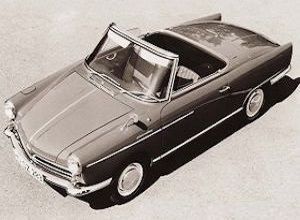Arotary engine is any power unit that dispenses with a crankshaft to eliminate reciprocal motion, giving nearperfect balance. German engineer Dr. Felix Wankel perfected the technology for road transport and, in 1964, the first car of its kind went on sale thanks to NSU, a German maker of scooters and economy cars.

NSU Wankel Spider 1963
- YEAR REVEALED 1963
- PLACE OF ORIGIN Neckarsulm, West Germany
- HISTORICAL STATUS production car
- ENGINE single-rotor rotary, 30ci (497cc)
- MAXIMUM POWER 50bhp
- LAYOUT rear-mounted engine driving the rear wheels
- BODYWORK two-door, two-seater roadster
- TOP SPEED 97mph (156kph)
- NUMBER BUILT 2,375
Wankel’s rotary engine had a single, shallow, lozenge-shaped combustion chamber in which a near-triangular rotary “piston” spun eccentrically. Wankel first envisaged rotary engines in 1924, and NSU became interested in his research and patents to boost performance of its racing motorcycles. Prototype engines were running by 1958 and the partners worked closely to resolve design issues.
By putting the engine into small-scale production in a specialized sports car, its reliability could be assessed without jeopardizing NSU’s profitability. The Spider hit the headlines in September 1963, and production starting the following year. The tiny Wankel engine was mounted under the trunk floor at the back: with a single rotor, the Spider could almost reach 100mph (161kph).
What it lacked in torque it made up for in free-revving smoothness, spinning happily to 8,000rpm. Critics praised its power delivery and handling, but the Spider, like all early rotaries, needed plentiful fuel and maintenance. Dr. Wankel, though, never experienced the thrill of driving it on open roads-he never had a driver’s license.